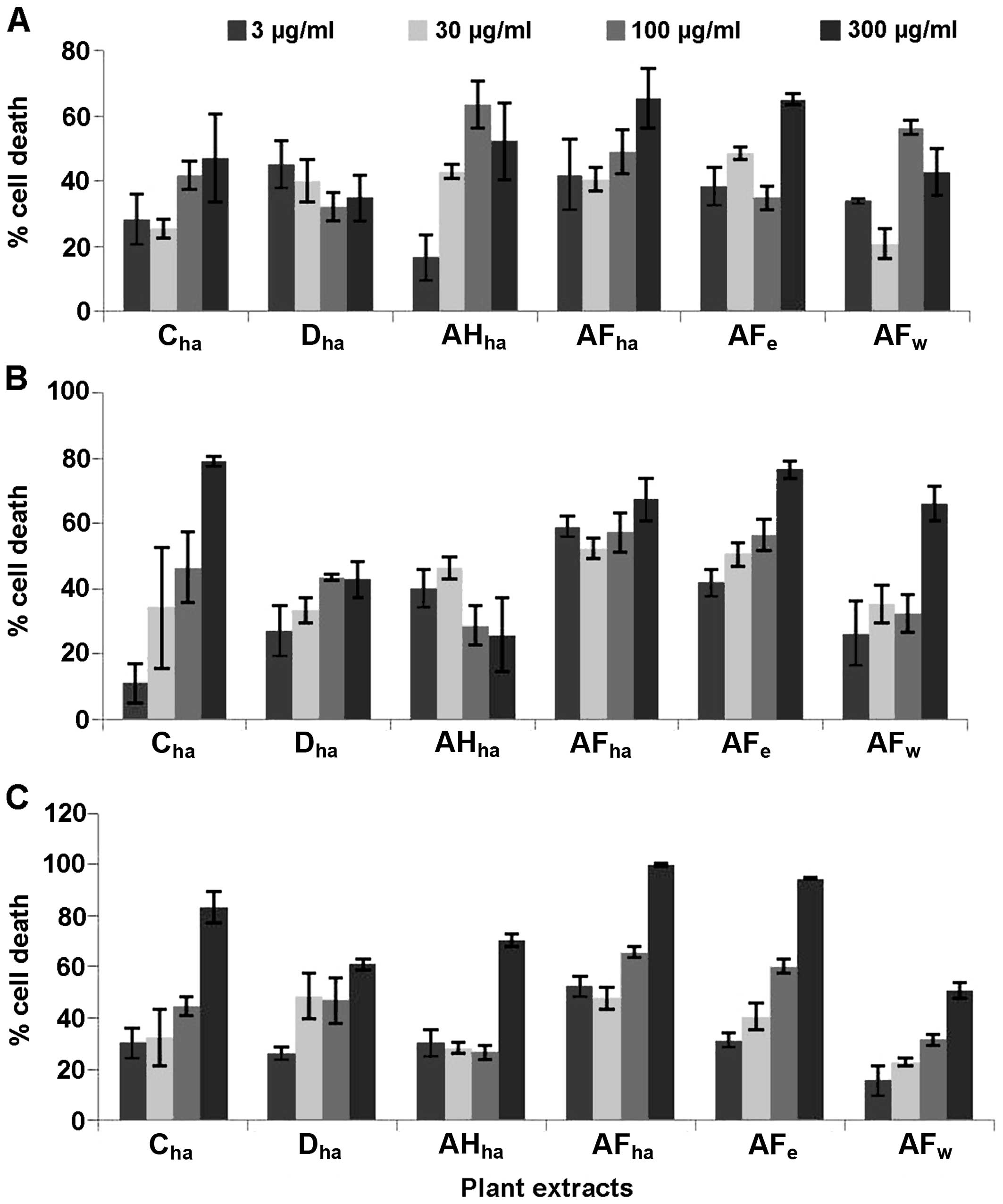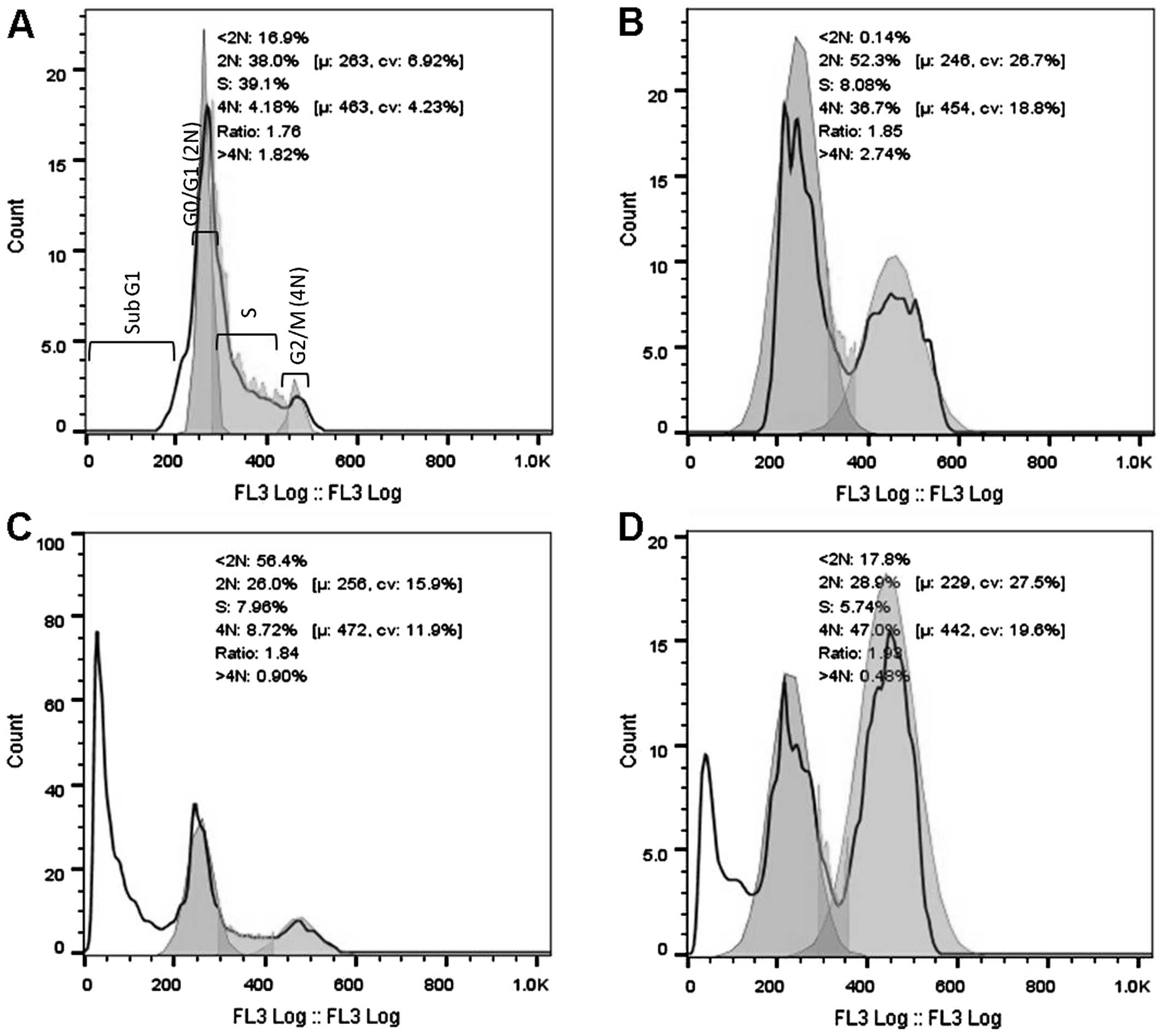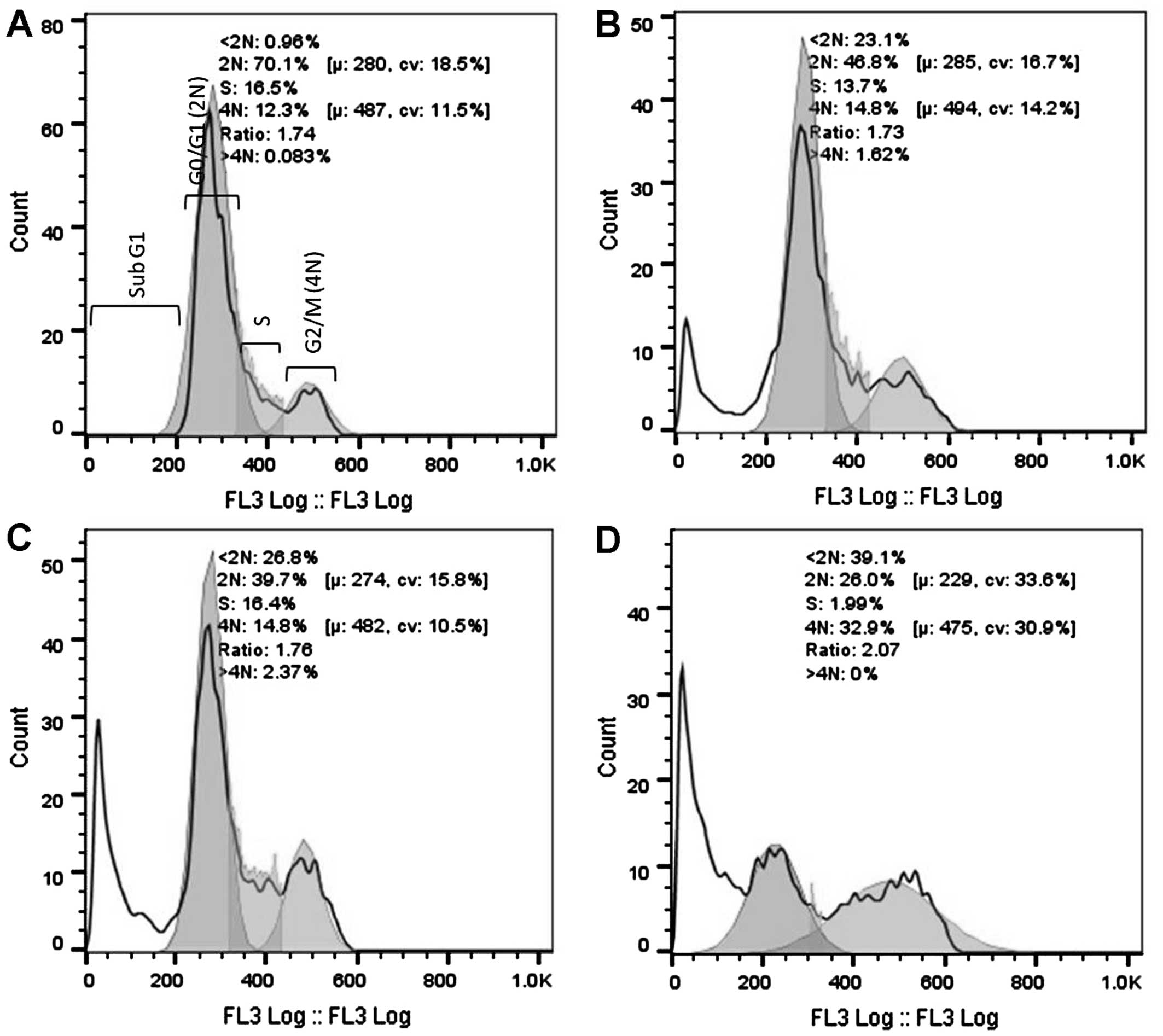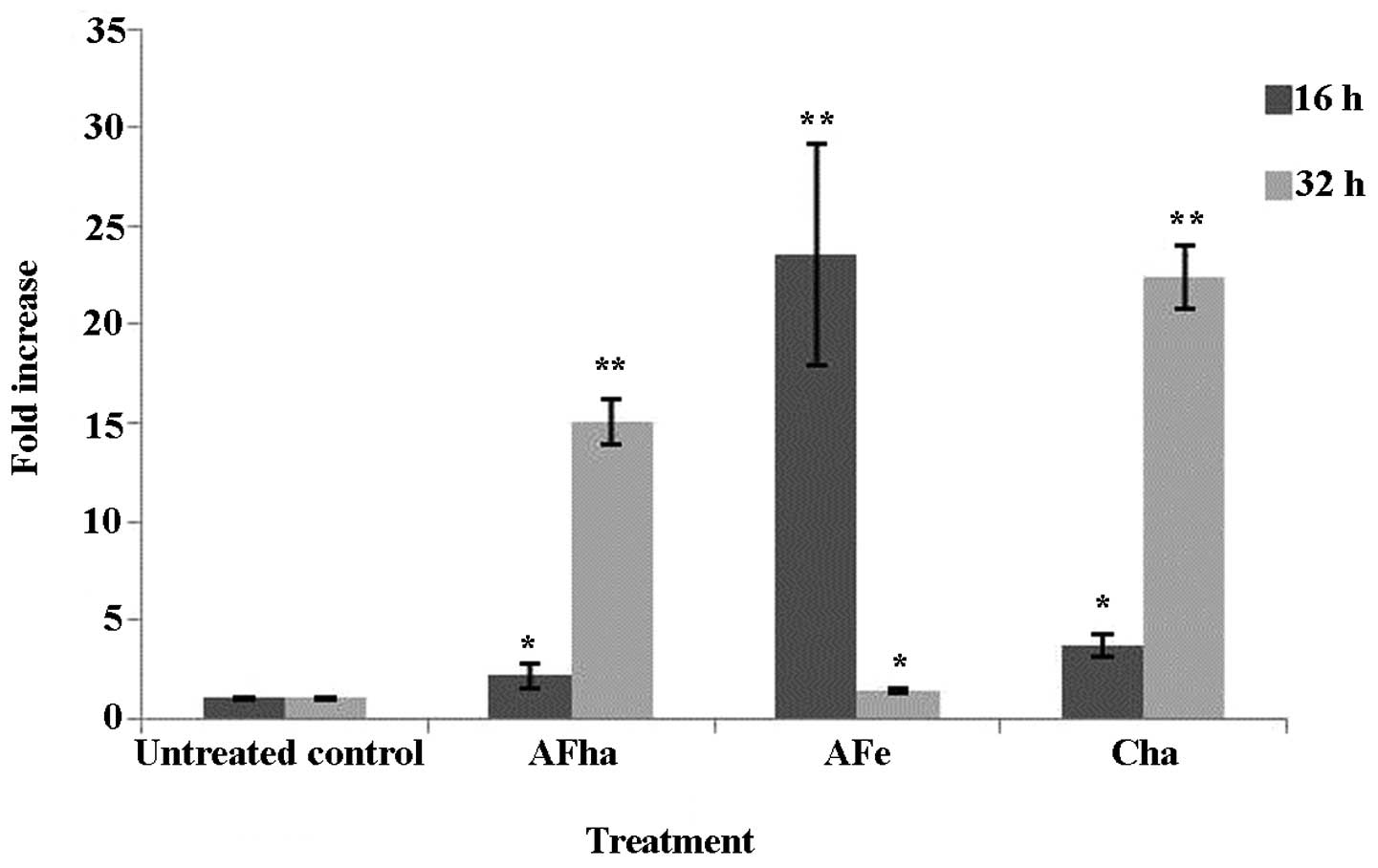|
1
|
Ridge CA, McErlean AM and Ginsberg MS:
Epidemiology of lung cancer. Semin Intervent Radiol. 30:93–98.
2013. View Article : Google Scholar : PubMed/NCBI
|
|
2
|
Baili P, Hoekstra-Weebers J, Van Hoof E,
Bartsch HH, Travado L, Garami M, Di Salvo F, Micheli A and Veerus
PEUROCHIP-3 Working group on Cancer Rehabilitation: Cancer
rehabilitation indicators for Europe. Eur J Cancer. 49:1356–1364.
2013. View Article : Google Scholar : PubMed/NCBI
|
|
3
|
Ferlay J, Steliarova-Foucher E,
Lortet-Tieulent J, Rosso S, Coebergh JW, Comber H, Forman D and
Bray F: Cancer incidence and mortality patterns in Europe:
Estimates for 40 countries in 2012. Eur J Cancer. 49:1374–1403.
2013. View Article : Google Scholar : PubMed/NCBI
|
|
4
|
Orlikova B and Diederich M: Power from the
garden: Plant compounds as inhibitors of the hallmarks of cancer.
Curr Med Chem. 19:2061–2087. 2012. View Article : Google Scholar : PubMed/NCBI
|
|
5
|
Gordaliza M: Natural products as leads to
anticancer drugs. Clin Transl Oncol. 9:767–776. 2007. View Article : Google Scholar : PubMed/NCBI
|
|
6
|
Karikas GA: Anticancer and chemopreventing
natural products: Some biochemical and therapeutic aspects. J BUON.
15:627–638. 2010.PubMed/NCBI
|
|
7
|
Tan G, Gyllenhaal C and Soejarto DD:
Biodiversity as a source of anticancer drugs. Curr Drug Targets.
7:265–277. 2006. View Article : Google Scholar : PubMed/NCBI
|
|
8
|
Singh M, Kaur M and Silakari O: Flavones:
An important scaffold for medicinal chemistry. Eur J Med Chem.
84:206–239. 2014. View Article : Google Scholar : PubMed/NCBI
|
|
9
|
Wu B, Zhang Q, Shen W and Zhu J:
Anti-proliferative and chemosensitizing effects of luteolin on
human gastric cancer AGS cell line. Mol Cell Biochem. 313:125–132.
2008. View Article : Google Scholar : PubMed/NCBI
|
|
10
|
Sak K: Cytotoxicity of dietary flavonoids
on different human cancer types. Pharmacogn Rev. 8:122–146. 2014.
View Article : Google Scholar : PubMed/NCBI
|
|
11
|
Patil JR, Chidambara Murthy KN,
Jayaprakasha GK, Chetti MB and Patil BS: Bioactive compounds from
Mexican lime (Citrus aurantifolia) juice induce apoptosis in
human pancreatic cells. J Agric Food Chem. 57:10933–10942. 2009.
View Article : Google Scholar : PubMed/NCBI
|
|
12
|
Russo P, Del Bufalo A and Cesario A:
Flavonoids acting on DNA topoisomerases: Recent advances and future
perspectives in cancer therapy. Curr Med Chem. 19:5287–5293. 2012.
View Article : Google Scholar : PubMed/NCBI
|
|
13
|
Tu SH, Ho CT, Liu MF, Huang CS, Chang HW,
Chang CH, Wu CH and Ho YS: Luteolin sensitises drug-resistant human
breast cancer cells to tamoxifen via the inhibition of cyclin E2
expression. Food Chem. 141:1553–1561. 2013. View Article : Google Scholar : PubMed/NCBI
|
|
14
|
Kuntz S, Wenzel U and Daniel H:
Comparative analysis of the effects of flavonoids on proliferation,
cytotoxicity, and apoptosis in human colon cancer cell lines. Eur J
Nutr. 38:133–142. 1999. View Article : Google Scholar : PubMed/NCBI
|
|
15
|
Mojzis J, Varinska L, Mojzisova G, Kostova
I and Mirossay L: Antiangiogenic effects of flavonoids and
chalcones. Pharmacol Res. 57:259–265. 2008. View Article : Google Scholar : PubMed/NCBI
|
|
16
|
Hou D-X and Kumamoto T: Flavonoids as
protein kinase inhibitors for cancer chemoprevention: Direct
binding and molecular modeling. Antioxid Redox Signal. 13:691–719.
2010. View Article : Google Scholar : PubMed/NCBI
|
|
17
|
Syed DN, Adhami VM, Khan MI and Mukhtar H:
Inhibition of Akt/mTOR signaling by the dietary flavonoid fisetin.
Anticancer Agents Med Chem. 13:995–1001. 2013. View Article : Google Scholar : PubMed/NCBI
|
|
18
|
Kong D, Zhang Y, Yamori T, Duan H and Jin
M: Inhibitory activity of flavonoids against class I
phosphatidylinositol 3-kinase isoforms. Molecules. 16:5159–5167.
2011. View Article : Google Scholar : PubMed/NCBI
|
|
19
|
Dai J and Mumper RJ: Plant phenolics:
Extraction, analysis and their antioxidant and anticancer
properties. Molecules. 15:7313–7352. 2010. View Article : Google Scholar : PubMed/NCBI
|
|
20
|
Dolečková I, Rárová L, Grúz J, Vondrusová
M, Strnad M and Kryštof V: Antiproliferative and antiangiogenic
effects of flavone eupatorin, an active constituent of chloroform
extract of Orthosiphon stamineus leaves. Fitoterapia.
83:1000–1007. 2012. View Article : Google Scholar : PubMed/NCBI
|
|
21
|
Kitdamrongtham W, Manosroi A, Akazawa H,
Gidado A, Stienrut P, Manosroi W, Lohcharoenkal W, Akihisa T and
Manosroi J: Potent anti-cervical cancer activity: Synergistic
effects of Thai medicinal plants in recipe N040 selected from the
MANOSROI III database. J Ethnopharmacol. 149:288–296. 2013.
View Article : Google Scholar : PubMed/NCBI
|
|
22
|
Holub J: Fallopia Adans. 1763
instead of Bilderdykia Dum. 1827. Folia Geobot Phytotaxon.
6:171–177. 1971.
|
|
23
|
Haraldson K: Anatomy and taxonomy in
Polygonaceae subfam. Polygonoideae Meisn. emend. Jaretzky. Symb.
Bot Upsal. 22:1–95. 1978.
|
|
24
|
Decraene LP and Akeroyd JR: Generic limits
in Polygonum L. and related genera (Polygonaceae) on the
basis of floral characters. J Linn Soc. 98:321–371. 1988.
View Article : Google Scholar
|
|
25
|
Nielsen H and Steinar H: Fallopia
Adans. Flora Nordica. Vol. 1: Lycopodiaceae to PolygonaceaeJonsell
B: Bergius Foundation; Stockholm: pp. 273–278. 2000
|
|
26
|
Song J, Yao H, Li Y, Li X, Lin Y, Liu C,
Han J, Xie C and Chen S: Authentication of the family Polygonaceae
in Chinese pharmacopoeia by DNA barcoding technique. J
Ethnopharmacol. 124:434–439. 2009. View Article : Google Scholar : PubMed/NCBI
|
|
27
|
Tiébré MS, Bizoux JP, Hardy OJ, Bailey JP
and Mahy G: Hybridization and morphogenetic variation in the
invasive alien Fallopia (Polygonaceae) complex in Belgium.
Am J Bot. 94:1900–1910. 2007. View Article : Google Scholar : PubMed/NCBI
|
|
28
|
Kim M, Hee Park J and Park CC: Flavonoid
chemistry of Fallopia section Fallopia
(Polygonaceae). Biochem Syst Ecol. 28:433–441. 2000. View Article : Google Scholar : PubMed/NCBI
|
|
29
|
Kim MH, Park JH, Won H and Park CW:
Flavonoid chemistry and chromosome numbers of Fallopia
section Pleuropterus (Polygonaceae). Can J Bot.
78:1136–1143. 2000. View Article : Google Scholar
|
|
30
|
Smolarz HD: Comparative study on the free
flavonoid aglycones in herbs of different species of
Polygonum L. Acta Pol Pharm. 59:145–148. 2002.PubMed/NCBI
|
|
31
|
Zhang CF, Chen J, Zhao LQ, Zhang D, Zhang
M and Wang ZT: Three new flavonoids from the active extract of
Fallopia convolvulus. J Asian Nat Prod Res. 13:136–142.
2011. View Article : Google Scholar : PubMed/NCBI
|
|
32
|
Olaru OT, Anghel AI, Istudor V, Ancuceanu
RV and Dinu M: Contributions to the pharmacognostical and
phytobiological study of Fallopia aubertii (L. Henry) Holub.
(Polygonaceae). Farmacia. 61:991–999. 2013.
|
|
33
|
Zhao YM, Qi HY and Shi YP: Several
chromones from the stems of Polygonum aubertii Henry. J
Asian Nat Prod Res. 12:623–628. 2010. View Article : Google Scholar : PubMed/NCBI
|
|
34
|
González M, Guzmán B, Rudyk R, Romano E
and Molina MA: Spectrophotometric determination of phenolic
compounds in propolis. Lat Am J Pharm. 22:243–248. 2003.
|
|
35
|
Chang CC, Yang MH, Wen HM and Chern JC:
Estimation of total flavonoid content in propolis by two
complementary colometric methods. J Food Drug Anal. 10:178–182.
2002.
|
|
36
|
Bazylko A, Parzonko A, Jez W, Osińska E
and Kiss AK: Inhibition of ROS production, photoprotection, and
total phenolic, flavonoids and ascorbic acid content of fresh herb
juice and extracts from the leaves and flowers of Tropaeolum
majus. Ind Crops Prod. 55:19–24. 2014. View Article : Google Scholar
|
|
37
|
Meyer BN, Ferrigni NR, Putnam JE, Jacobsen
LB, Nichols DE and McLaughlin JL: Brine shrimp: A convenient
general bioassay for active plant constituents. Planta Med.
45:31–34. 1982. View Article : Google Scholar
|
|
38
|
Fan W, Cui M, Liu H, Wang C, Shi Z, Tan C
and Yang X: Nano-TiO2 enhances the toxicity of copper in
natural water to Daphnia magna. Environ Pollut. 159:729–734.
2011. View Article : Google Scholar : PubMed/NCBI
|
|
39
|
Nitulescu GM, Draghici C and Olaru OT: New
potential antitumor pyrazole derivatives: Synthesis and cytotoxic
evaluation. Int J Mol Sci. 14:21805–21818. 2013. View Article : Google Scholar : PubMed/NCBI
|
|
40
|
Gong Y, Liu X, He WH, Xu HG, Yuan F and
Gao YX: Investigation into the antioxidant activity and chemical
composition of alcoholic extracts from defatted marigold
(Tagetes erecta L.) residue. Fitoterapia. 83:481–489. 2012.
View Article : Google Scholar : PubMed/NCBI
|
|
41
|
Ghitescu RE, Volf I, Carausu C, Bühlmann
AM, Gilca IA and Popa VI: Optimization of ultrasound-assisted
extraction of polyphenols from spruce wood bark. Ultrason Sonochem.
22:535–541. 2015. View Article : Google Scholar : PubMed/NCBI
|
|
42
|
Olaru OT, Ancuceanu RV, Anghel AI and Dinu
M: Șeremet OC and Istudor V: Botanical investigation of Fallopia
dumetorum (L.) Holub (Polygonaceae) and qualitative and
quantitative assessment of its polyphenolic compounds. Acta Med
Marisiensis. 60:67–71. 2014.
|
|
43
|
Olaru OT, Anghel AI, Istudor V and Olaru
II: The qualitative and quantitative determination of the phenolic
compounds in Polygonum convolvulus L. species, Polygonaceae
family. Acta Med Marisiensis. 59:162–164. 2013.
|
|
44
|
Sultana B, Anwar F and Ashraf M: Effect of
extraction solvent/technique on the antioxidant activity of
selected medicinal plant extracts. Molecules. 14:2167–2180. 2009.
View Article : Google Scholar : PubMed/NCBI
|
|
45
|
Sahpazidou D, Geromichalos GD, Stagos D,
Apostolou A, Haroutounian SA, Tsatsakis AM, Tzanakakis GN, Hayes AW
and Kouretas D: Anticarcinogenic activity of polyphenolic extracts
from grape stems against breast, colon, renal and thyroid cancer
cells. Toxicol Lett. 230:218–224. 2014. View Article : Google Scholar : PubMed/NCBI
|
|
46
|
Sun T, Chen QY, Wu LJ, Yao XM and Sun XJ:
Antitumor and antimetastatic activities of grape skin polyphenols
in a murine model of breast cancer. Food Chem Toxicol.
50:3462–3467. 2012. View Article : Google Scholar : PubMed/NCBI
|
|
47
|
Busino L, Chiesa M, Draetta GF and
Donzelli M: Cdc25A phosphatase: Combinatorial phosphorylation,
ubiquitylation and proteolysis. Oncogene. 23:2050–2056. 2004.
View Article : Google Scholar : PubMed/NCBI
|
|
48
|
Smiley ST, Reers M, Mottola-Hartshorn C,
Lin M, Chen A, Smith TW, Steele GD Jr and Chen LB: Intracellular
heterogeneity in mitochondrial membrane potentials revealed by a
J-aggregate-forming lipophilic cation JC-1. Proc Natl Acad Sci USA.
88:3671–3675. 1991. View Article : Google Scholar : PubMed/NCBI
|
|
49
|
Saelens X, Festjens N, Vande Walle L, van
Gurp M, van Loo G and Vandenabeele P: Toxic proteins released from
mitochondria in cell death. Oncogene. 23:2861–2874. 2004.
View Article : Google Scholar : PubMed/NCBI
|
|
50
|
Guilhermino L, Diamantino T, Silva MC and
Soares AM: Acute toxicity test with Daphnia magna: An
alternative to mammals in the prescreening of chemical toxicity?
Ecotoxicol Environ Saf. 46:357–362. 2000. View Article : Google Scholar : PubMed/NCBI
|
|
51
|
Hartl M and Humpf HU: Toxicity assessment
of fumonisins using the brine shrimp (Artemia salina)
bioassay. Food Chem Toxicol. 38:1097–1102. 2000. View Article : Google Scholar : PubMed/NCBI
|
|
52
|
Logarto Parra A, Silva Yhebra R, Guerra
Sardiñas I and Iglesias Buela L: Comparative study of the assay of
Artemia salina L. and the estimate of the medium lethal dose
(LD50 value) in mice, to determine oral acute toxicity of plant
extracts. Phytomedicine. 8:395–400. 2001. View Article : Google Scholar : PubMed/NCBI
|


















